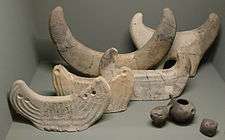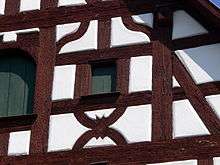Andiron
.png)
An andiron (older form anderne; med. Lat. andena, anderia) is a horizontal iron bar upon which logs are laid for burning in an open fireplace. They are usually used in pairs to build up a firedog in American English, sometimes called a dog or dog-iron, intended to hold logs above the hearth in order to improve air circulation for better burning. In older eras (e.g. 16th to 18th century AD) andirons were used as a rest for a roasting spit; and sometimes included a cup-shaped top to hold porridge. The earliest andirons were forged from wrought iron.[1]
Usage

Andirons and fire dogs are devices made of metal or ceramic which support the firewood so that a draft of air may pass around it, allowing proper burning and thus reducing smoke. They normally stand upon short legs and are usually connected with an upright guard. The guard keeps the logs in the fireplace as they burn and settle. This guard, which may be of iron, steel, copper, bronze, or even silver, may be simple, or elaborately ornamented (often with patterns or heraldic ornaments, such as the fleur-de-lis, with sphinxes, grotesque animals, mythological statuettes, or caryatides supporting heroic figures or emblems). A common decoration in the form of a canine plays on the dual meanings of the word dog (canine and inanimate holder or blocker).
History




Andirons, or fire dogs, had been in use by the Ancient Greeks, and were called krateutai (Greek: κρατευταί[2]). Excavations made on the Greek island of Santorini, unearthed stone sets of firedogs used before the 17th century BC. In each pair of the supports, the receptacles to hold skewers or spits were found in equivalence, while the line of small openings in the base formed a mechanism to supply the coals with oxygen so that they remained alight during its use.[3]
Fire dogs were also referred to as moon idols (or moon horns)[4] in antiquity. They may also refer to an artifact-type of late Bronze Age Europe (ca. 1300 to 800 BC). Typically made of clay, they have been found in areas of modern France, Switzerland and Germany; often associated with the Urnfield culture. This naming suggests that moon idols could have been used as andirons to build up fire dogs.
In some cases, moon idols are a cult item of Early European Religions, resembling a pair of horns or crescent moons on a pedestal, and were variously interpreted as testifying to Bull worship, Moon worship, or as a holder for wooden logs to be used in a fire altar.
Previous to the Italian Renaissance, andirons were almost invariably made entirely of iron and were of comparatively plain design, but when the ordinary objects of the household became the care of the artist, the metalworker lavished skill and taste upon them. Men such as Jean Berain, whose artistry was most especially applied to the ornamentation of Boulle furniture, sometimes designed them. The andiron reached its greatest artistic development under Louis XIV of France, and the first extant examples—often made of cast iron—are to be found in French museums and royal palaces. Firedogs, with little or no ornamentation and made of metal or ceramics, were used in kitchens, with ratcheted uprights for the spits. Very often these uprights branched out into arms, or hobs, for stewing or keeping food hot.[5]
See also
References
- ↑ Metalwork from the Index of American Design
- ↑ κρατευταί; Liddell, Henry George, and Scott, Robert; A Greek-English Lexicon; on Perseus
- ↑ To Vima (in Greek)]; 6-2-2011; picture 2.
- ↑ German: Mondhorn
- ↑ Fireplace Andirons from Fireplaces Magazine.
 This article incorporates text from a publication now in the public domain: Chisholm, Hugh, ed. (1911). "Andiron". Encyclopædia Britannica (11th ed.). Cambridge University Press.
This article incorporates text from a publication now in the public domain: Chisholm, Hugh, ed. (1911). "Andiron". Encyclopædia Britannica (11th ed.). Cambridge University Press.
Further reading
- Babes, M. und Mihailescu-Bîrliba, V.: Germanische latènezeitliche "Feuerböcke" aus der Moldau 1971
- Mondhörner - "Urgeschichtliche Messgeräte" in Helvetica Archäologica 32/2001
- Derungs K.: Geheimnisvolles Zürich ISBN 3-905581-22-1
- Steuer, H.: "Germanische 'Feuerböcke' aus dem Hannoverschen Wendland", Arch. Korrespondenzbl. 3, 1973